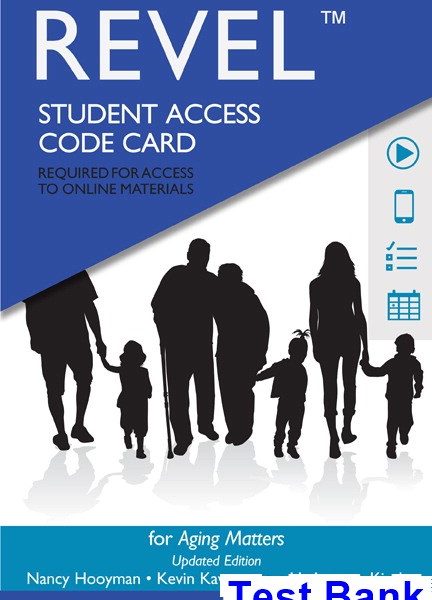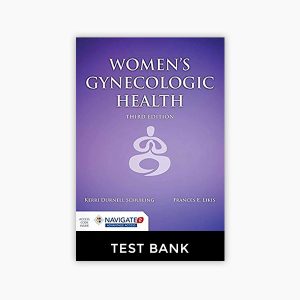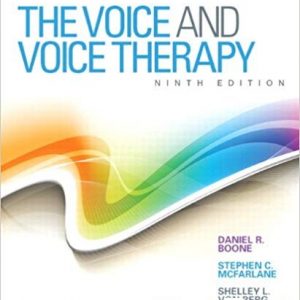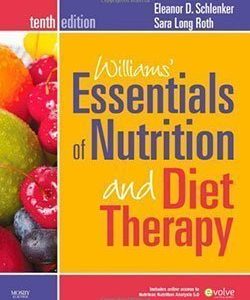This is completed downloadable of Aging Matters 1st Edition Hooyman Test Bank
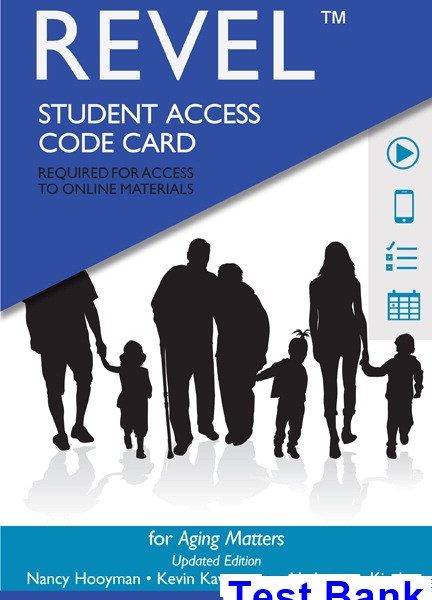
Product Details:
- ISBN-10 : 0133974022
- ISBN-13 : 978-0133974027
- Author:
This edition features the same content as the traditional text in a convenient, three-hole-punched, loose-leaf version. Books a la Carte also offer a great value—this format costs significantly less than a new textbook.
Presents Social Gerontology from Multiple Perspectives
Aging Matters illuminates cultural, biological, physiological, emotional, cognitive, economic, and social aspects of aging. A useful guide to a range of disciplines, this title helps readers of all educational backgrounds understand the dynamic interactions between older people and their environments.
Table of Content:
- I.2 Why Study Gerontology?
- I.2.1 A Life Course and Strengths Perspective
- I.2.2 Multidisciplinary Perspective
- I.3 Key Terms
- I.3.1 How Do We Define Age?
- I.4 How Do We Study Older Adults?
- I.4.1 Research Methods
- Summary
- An Introduction to Social Gerontology
- Chapter 1 The Older Population in the United States
- Learning Objectives
- Introduction The Older Population in the United States
- 1.1 Changing Demographics of the U.S. Population
- 1.1.1 Changes in Life Expectancy
- 1.1.2 Gender Differences in Life Expectancy
- 1.1.3 Racial Differences in Life Expectancy
- 1.2 Maximum Life Span
- 1.2.1 Population Pyramids
- 1.3 Support and Dependency Ratios
- 1.4 The Rapid Growth of the Old-Old and Oldest-Old
- 1.4.1 Who Are the Oldest-Old?
- 1.4.2 Centenarians and Super-Centenarians
- The Role of Genes
- Evidence for a Genetic Role in Becoming a Centenarian
- Aging Well as Centenarians and Oldest-Old
- The Role of the Environment
- 1.5 Increasing Diversity among the Older Population
- 1.5.1 Elders of Color
- 1.5.2 Lesbian, Gay, Bisexual, and Transgender (LGBT) Elders
- 1.5.3 Geographic Distribution
- 1.5.4 Geographic Distribution among Elders of Color
- 1.5.5 Educational and Economic Status
- 1.6 Longevity in Health or Disease? What Does the Future Hold?
- Summary
- The Older Population in the United States
- Chapter 2 Global Aging and Older Immigrants in the United States
- Learning Objectives
- Introduction Global Aging and Older Immigrants in the United States
- 2.1 Global Trends in Aging
- 2.1.1 Global Aging, Median Age, and Population Pyramids
- Median Age
- 2.1.2 What It Means To Be Old around the World
- Baby Boomers in Japan
- 2.2 Economic Implications for Industrialized Countries
- 2.3 Older Europeans in the Workforce
- 2.4 Older Adults in Traditional Societies and the Impact of Modernization
- 2.4.1 Modernization Theory
- 2.4.2 Modernization and Elders’ Declining Social Status
- 2.4.3 Impact of Modernization on Respect and Care toward Elders in Asian Cultures
- 2.5 Immigrants to the United States
- 2.5.1 Immigrant Elders’ Changing Roles and Expectations
- 2.5.2 Financial Dilemmas Facing Immigrant Elders
- 2.5.3 Immigrant Elders in Multigenerational Households
- 2.5.4 Additional Challenges Faced by Older Refugees
- Summary
- Global Aging and Older Immigrants in the United States
- Chapter 3 Physical Well-Being Physiological Changes and Health
- Learning Objectives
- Introduction Physical Well-Being: Physiological Changes and Health
- 3.1 Biological Theories of Aging
- 3.1.1 Can Aging Be Reversed or Delayed?
- 3.2 “Normal” Physiological Changes with Age
- 3.2.1 Changes in Body Composition
- 3.2.2 Changes in the Skin and Hair
- 3.2.3 Organ Systems
- Musculoskeletal and Kinesthetic Systems
- Respiratory System
- Cardiovascular Changes
- Urinary System
- Gastrointestinal System
- Endocrine System
- Immune System
- Nervous System
- 3.2.4 Physiological Changes and Sexuality
- Women and Age-Related Physiological Changes
- Men and Age-Related Physiological Changes
- 3.2.5 Sleep Patterns
- 3.2.6 Sensory Functions
- Vision
- Hearing
- Taste and Smell
- Touch
- 3.3 Defining Health and Functional Ability
- 3.3.1 Are Disability Rates Declining?
- 3.3.2 Chronic and Acute Diseases
- 3.3.3 Health Disparities
- 3.3.4 Primary Causes of Death in Old Age
- 3.4 Common Chronic Diseases
- 3.4.1 Heart Disease and the Cardiovascular System
- 3.4.2 Strokes and Other Cerebrovascular Problems
- 3.4.3 Cancer
- 3.4.4 Arthritis
- 3.4.5 Osteoporosis or “Weak Bones”
- 3.4.6 Chronic Obstructive Pulmonary Disease or Respiratory Problems
- 3.4.7 Diabetes
- 3.4.8 Problems with the Kidneys and Urinary Tract
- 3.4.9 Problems with the Intestinal System
- 3.4.10 Oral Diseases
- 3.4.11 HIV (Human Immunodeficiency Virus) or AIDS (Acquired Immune Deficiency Syndrome)
- 3.5 Accidents
- 3.5.1 Older Drivers
- 3.5.2 Falls and Their Prevention
- 3.6 Use of Physician Services
- 3.6.1 Hospital Utilization
- 3.6.2 Medication Use
- 3.7 Health Promotion
- 3.7.1 Exercise as Central to Health Promotion
- 3.7.2 Nutrition
- 3.7.3 Programs That Work
- 3.7.4 Improving the Impact of Health Promotion Programs
- Summary
- Physical Well-Being: Physiological Changes and Health
- Chapter 4 Mental and Emotional Well-Being
- Learning Objectives
- Introduction Mental and Emotional Well-Being
- 4.1 Aging and Cognitive Function
- 4.1.1 Intelligence and Aging
- 4.1.2 What Else Besides Age Affects Intelligence?
- 4.1.3 How Aging Affects Learning and Memory
- 4.1.4 Executive Function in Older Adults
- Factors that Affect Learning in Old Age
- Strategies to Promote Older Adults’ Learning
- Age-Related Changes in Memory
- 4.1.5 Improving Cognitive Abilities
- 4.1.6 Memory Mediators
- External Cognitive Aids
- 4.1.7 Physical Exercise
- Do Chemical Aids Improve Memory?
- 4.1.8 Wisdom and Creativity
- 4.2 Personality in the Later Years
- 4.2.1 Stage Theories of Personality
- Erikson’s Psychosocial Model of Personality
- 4.2.2 Trait Theories of Personality
- 4.2.3 Emotional Expression and Regulation
- 4.2.4 Self-Concept and Self-Esteem
- 4.2.5 Successful, Robust, Resilient, or Positive Aging
- 4.3 Mental Disorders among Older Persons
- 4.3.1 Depression
- Risk Factors for Depression
- Diagnosing Depression
- Therapeutic Interventions
- 4.3.2 Suicide
- 4.3.3 Anxiety
- 4.3.4 Paranoia and Schizophrenia
- 4.3.5 Older Adults Who Are Chronically or Severely Mentally Ill
- 4.3.6 Dementia
- Reversible and Irreversible Causes of Dementia
- 4.3.7 Alzheimer’s Disease (AD)
- Differentiating AD from Normal Age-Related Memory Changes
- Potential Causes of and Risk Factors for Alzheimer’s Disease
- The Importance of a Thorough Diagnosis
- Stages of Alzheimer’s Disease
- Drug Therapy
- Behavioral Treatment and Environmental Interventions
- Parkinson’s Disease
- 4.3.8 Substance Use
- Alcoholism
- Drug Abuse
- Medication Misuse Can Threaten Elders’ Independence
- Summary
- Mental and Emotional Well-Being
- Chapter 5 Social Theories of Aging
- Learning Objectives
- Introduction Social Theories of Aging
- 5.1 The Importance of Social Theories of Aging
- 5.2 Social Gerontological Theory before 1961 Role and Activity
- 5.2.1 Role Theory
- Age Norms
- Role Loss
- 5.2.2 Activity Theory
- 5.3 The Next Stage of Theory Development Disengagement and Continuity Theory
- 5.3.1 Disengagement Theory
- 5.3.2 Continuity Theory
- 5.4 Newer Social Theoretical Perspectives
- 5.4.1 Age Stratification Theory
- 5.4.2 Social Exchange Theory
- 5.4.3 Life Course Perspective
- 5.4.4 Political Economy Theory of Aging
- 5.4.5 Social Constructionism
- 5.5 Recent Developments in Social Gerontological Theory
- 5.5.1 Social Phenomenology
- 5.5.2 Feminist Gerontology
- 5.5.3 The Interconnections of Gender, Race, and Sexual Orientation
- Summary
- Social Theories of Aging
- Chapter 6 Family, Friends, and Other Informal Supports
- Learning Objectives
- Introduction Family, Friends, and Other Informal Supports
- 6.1 We All Need Informal Social Support
- 6.1.1 The Benefits of Social Supports
- 6.1.2 Do Social Supports Change as We Age?
- 6.1.3 What Factors Affect Our Social Relationships?
- 6.2 The Centrality of Family Supports
- 6.2.1 Families Are Changing
- 6.2.2 The Growth of the Multigenerational Family
- 6.3 Older Partners as Social Support
- 6.3.1 Older Adults and Marriage
- Marital Satisfaction
- Divorce in Old Age
- Remarriage and Other Late-Life Romantic Relationships
- Dating in Old Age
- 6.3.2 Never-Married Older People
- 6.3.3 Childless Older Adults
- 6.4 Lesbian, Gay, Bisexual, and Transgender (LGBT) Partners
- 6.4.1 What We Now Know about Older LGBT Families
- 6.4.2 Effects of Race, Class, and Cohort with Sexual Identity
- LGBT Elder-Friendly Organizations
- 6.4.3 Barriers to Supports for LGBT Elders
- 6.4.4 Working with LGBT Elders
- 6.5 Sexuality, Intimacy, and Emotional Support
- 6.5.1 What We Know about Older Adults and Sexuality
- 6.6 Other Types of Family Supports
- 6.6.1 Relationships with Adult Children
- 6.6.2 Sibling Relationships
- 6.6.3 Grandparenthood and Great-Grandparenthood
- 6.6.4 Friends and Neighbors as Social Supports
- Programs to Strengthen or Build Neighborhood and Community Supports
- Intergenerational Programs
- 6.6.5 The Unconditional Love of Pets
- Summary
- Family, Friends, and Other Informal Supports
- Chapter 7 Informal and Family Caregiving
- Learning Objectives
- Introduction Informal and Family Caregiving
- 7.1 What Is Informal Caregiving?
- 7.1.1 What Kind of Informal Care Do Some Older Adults Need?
- 7.1.2 Who Are Informal Caregivers?
- 7.1.3 Losses and Gains of Informal Care
- Costs of Informal Caregiving
- Benefits of Informal Caregiving
- 7.1.4 Adult Children as Caregivers
- The Gendered Nature of Caregiving
- Women in the Middle
- 7.1.5 Spouses/Partners as Caregivers
- 7.1.6 Family Caregivers of Color
- 7.1.7 Friends as Caregivers
- 7.1.8 Caregiving for Persons with Dementia
- 7.1.9 Grandparents as Primary Caregivers
- 7.1.10 Legal Issues Related to Grandparent Caregiving
- 7.1.11 Legislation and Policies to Support Family Caregivers
- 7.2 Services and Support for Caregivers
- 7.2.1 Why Don’t Caregivers Use Services?
- 7.2.2 Effective Evidence-Based Interventions
- Psychoeducational Groups, Skills Training, and Treatments
- Support Groups
- Modifying the Home Environment
- Respite Care
- Camps for Caring
- Electronic Supports
- 7.2.3 Future Service Directions
- 7.3 When Caregiving Becomes Too Much
- 7.3.1 Placement in Long-Term Care Facilities
- 7.3.2 Elder Mistreatment
- Financial Abuse and Exploitation
- Reporting and Other Legal Requirements
- Adult Protective Services
- 7.4 Underpaid Caregivers Direct Care Workers
- 7.4.1 Economic and Health Disparities Faced by Direct Care Workers
- 7.4.2 Future Demand
- Summary
- Informal and Family Caregiving
- Chapter 8 Productive Aging Leisure, Spirituality, and Civic Engagement
- Learning Objectives
- Introduction Productive Aging: Leisure, Spirituality, and Civic Engagement
- 8.1 Defining Productive Aging
- 8.2 Leisure
- 8.3 Religious Participation, Religiosity, and Spirituality
- 8.3.1 Defining Religion, Religiosity, and Spirituality
- 8.3.2 Religious Affiliation
- Age, Gender, and Race
- 8.3.3 Religiosity
- Benefits of Religious Participation and Religiosity for Older Adults
- Other Factors to Consider Regarding Religion and Health
- 8.3.4 Spiritual Well-Being
- Implications for Health Care Providers
- Stages of Spiritual Growth
- 8.4 Civic Engagement
- 8.4.1 Civic Engagement
- Toward What End?
- 8.4.2 Membership in Voluntary Associations
- Patterns of Membership
- 8.4.3 Senior Centers
- Are They Prepared for Changing Demographics?
- 8.4.4 Volunteering
- Benefits of Volunteerism
- Race, Social Class, and Volunteering
- 8.4.5 Lifelong Learning Programs
- 8.4.6 Political Participation
- Do Older Adults Become More Politically Conservative with Age?
- Voting Behavior
- Are Older Adults a Powerful Political Constituency?
- 8.4.7 AARP—The Largest Membership Organization in the Country
- Is AARP for All Older Adults?
- 8.4.8 Looking Toward the Future of Productive Aging
- Summary
- Productive Aging: Leisure, Spirituality, and Civic Engagement
- Chapter 9 Loss and Grief in Old Age
- Learning Objectives
- Introduction Loss and Grief in Old Age
- 9.1 Loss and Grief within the Context of Aging
- 9.1.1 The Nature of Grief
- 9.1.2 Typical Losses Faced by Older Adults
- Relocation
- Retirement
- Caring for a Relative with Chronic Illness or Disability
- Caring for Adult Children with Chronic Illness or Disabilities
- Living with Chronic Illness or Disability
- 9.2 Death of Loved Ones
- 9.2.1 Death of a Partner
- 9.2.2 Death of Siblings
- 9.2.3 Death of Friends
- 9.3 Approaching One’s Own Death and the Dying Process
- 9.3.1 The Dying Process
- 9.3.2 Desire for a Good Death
- 9.3.3 End-of-Life Care
- Palliative Care and Hospice
- 9.3.4 Culturally Appropriate End-of-Life Care
- 9.3.5 The Right to Die
- Hastened Death and Physician Aid-in-Dying
- Patients’ Legal Options Regarding Their End-of-Life Care
- Summary
- Loss and Grief in Old Age
- Chapter 10 Economic Well-Being Retirement, Employment, and Poverty
- Learning Objectives
- Introduction Economic Well-Being: Retirement, Employment, and Poverty
- 10.1 Retirement
- 10.1.1 Baby Boomers and Changing Expectations of Retirement
- 10.1.2 The Timing of Retirement
- 10.2 Employment
- 10.2.1 Unemployment
- 10.2.2 Barriers to Employment
- 10.3 Economic Status
- 10.3.1 What Are the Major Sources of Income for Older Adults?
- Social Security
- Assets
- Pensions Other Than Social Security
- Earnings
- Public Assistance
- 10.3.2 Social Class and Poverty in Old Age
- Are Older Adults Poorer Than Other Age Groups?
- Limitations of Official Poverty Statistics
- Poverty Variations by Race, Gender, and Sexual Orientation
- 10.3.3 Hunger Is Increasing among Older Americans
- 10.4 Changing Conceptions of Work and Retirement
- Summary
- Economic Well-Being: Retirement, Employment, and Poverty
- Chapter 11 Community Well-Being Living Arrangements and Social Interactions
- Learning Objectives
- Introduction Community Well-Being: Living Arrangement and Social Interactions
- 11.1 The Aging Experience in Rural, Urban, and Suburban Areas
- 11.1.1 How and Where Elders Live Affects Their Well-Being
- 11.1.2 Relocation
- 11.2 Housing Patterns of Older People
- 11.2.1 Independent Housing
- 11.2.2 Aging in Place
- Age-Friendly/Livable Communities
- Flexible Housing and Universal Design
- Additional Innovations for Aging in Place
- 11.2.3 Planned “Retirement” Housing
- Continuing Care Retirement Communities
- Assisted Living
- Private Homes that Offer Long-Term Supports
- Skilled Nursing Facilities (SNFS)
- 11.2.4 Culture Change in Long-Term Care
- 11.3 Social and Health Services to Promote Aging in Place
- 11.3.1 Home Care
- 11.3.2 Adult Day Care and Adult Day Health Care
- 11.4 Housing Policy and Growing Housing Needs
- 11.4.1 Homelessness Aging in Place on the Streets
- 11.4.2 Aging in Place among Older Prisoners
- Summary
- Community Well-Being: Living Arrangements and Social Interactions
- Chapter 12 Enhancing Older Adults’ Well-Being through Technology
- Learning Objectives
- Introduction Enhancing Older Adults’ Well-Being through Technology
- 12.1 Information and Communication Technologies
- 12.1.1 Intergenerational Communication
- 12.1.2 Lifelong Learning
- 12.1.3 News and Information
- 12.2 Managing Health Online
- 12.2.1 Health Information on the Internet
- 12.2.2 Health Plans Online
- 12.2.3 Telehealth
- 12.2.4 Health Consultation Online
- 12.3 Technology in the Workplace
- 12.4 Technologies to Help Aging in Place
- 12.4.1 Universal Design
- 12.4.2 Smart Homes
- Researching Smart Homes and Universal Design
- 12.4.3 Gerontechnology
- Remote Patient Monitoring
- 12.4.4 Developing Technologies for Older Adults
- 12.5 Can Computer Games Promote Elders’ Well-Being?
- 12.5.1 Computer Games and Physical Exercise
- Summary
- Enhancing Older Adults’ Well-Being through Technology
- Chapter 13 Policies to Promote Older Adults’ Well-Being
- Learning Objectives
- Introduction Policies to Promote Older Adults’ Well-Being
- 13.1 Understanding Policies, Programs, and Regulations
- 13.1.1 Separating Fact from Fiction about Age-Based Policies
- 13.1.2 Criteria by Which Policies Vary
- 13.1.3 Factors That Influence the Development of Public Policies
- Values Affecting Social Policy
- 13.1.4 Intergenerational Inequity versus Interdependence
- 13.2 Historical, Economic, and Political Context
- 13.2.1 The First Policies to Benefit Older Americans, 1930s–1950s
- 13.2.2 Expansion of Age-Based Programs in the 1960s and 1970s
- “Compassionate Stereotypes” about Older Adults
- 13.2.3 Cost Efficiency and Program Reductions in the 1980s and 1990s
- 13.2.4 Since 2000
- Market and Personal Responsibility and Reduced Government Spending
- 13.3 Social Security An Income Security Program
- 13.3.1 The Goals of Social Security
- 13.3.2 The Cross-Generational Nature of Social Security
- 13.3.3 The Future of Social Security
- Proposed Changes to Social Security
- Proposals to Reduce Gender Inequities in Social Security
- 13.4 Social Services through the Older Americans Act
- 13.5 Medicare and Medicaid
- 13.5.1 Medicare
- Medicare-Funded Home Health Care
- Medicare Reform and Prescription Drug Coverage
- The Future of Medicare
- 13.5.2 Medicaid
- Medicaid-Funded Skilled Nursing Home Care
- Medicaid-Funded Home Health Care
- 13.6 Directions in Long-term Services and Supports
- 13.6.1 Long-Term Care Insurance
- 13.6.2 Policies to Promote Innovative Health and Long-Term Care Services
- 13.6.3 Benefits of Health Care Reform for Older Adults
- Summary
- Policies to Promote Older Adults’ Well-Being
- Chapter 14 Careers in Aging
- Learning Objectives
- Introduction Careers in Aging
- 14.1 Why Consider a Career in Aging?
- 14.2 The Wide Range of Jobs in Aging
- 14.3 Preparing for a Career in Aging
- 14.3.1 Academic Programs in Aging
- Workforce Initiatives in Medicine, Nursing, and Social Work
- Interdisciplinary Teams
- 14.3.2 Internships and Other Training Opportunities
- Journaling as a Self-Discovery Tool
- 14.4 A Multidisciplinary, Multigenerational Outlook
- Summary
- Careers in Aging
- Glossary
- References
- Credits
- Introduction
- Chapter 1
- Chapter 2
- Chapter 3
- Chapter 4
- Chapter 5
- Chapter 6
- Chapter 7
- Chapter 8
- Chapter 9
- Chapter 10
- Chapter 11
- Chapter 12
- Chapter 13
- Chapter 14
- Index
- A
- B
- C
- D
- E
- F
- G
- H
- I
- J
- K
- L
- M
- N
- O
- P
- Q
- R
- S
- T
- U
- V
- W
- Y

